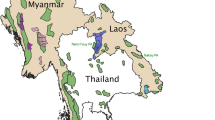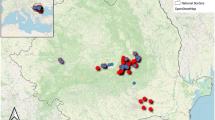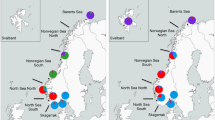Abstract
We tested the genetic and ecological differences between neighbouring urban and rural populations of common kestrels (Falco tinnuculus) in southern Bohemia. The aims were to (1) assess the genetic variability of the studied kestrel populations using microsatellite markers, (2) check the genetic relatedness of individuals within the urbanization gradient, and (3) compare possible gradients of body characteristics and reproductive parameters on the urbanization gradient. The mean expected allelic polymorphism did not differ among the studied populations, which were not genetically separated (F ST = 0.0003, P = 0.781). Also, an individual assignment test did not show a separation of these populations. Urban kestrels that bred in the city centre were indicatively more related than others, and no relationship was found in the rural kestrel population. Kestrel females were heavier towards the city centre, but males did not show this relationship. Nest distance from the city centre had no significant effect on any of the tested reproductive parameters. Our results do not support the notion of genetic differentiation between rural and urban kestrels, but revealed trends in body characteristics and genetic relatedness along the urbanization gradient.




Similar content being viewed by others
References
Andrzejewski R, BabinskaWerka J, Gliwicz J, Goszczyński J (1978) Synurbization processes in an urban population of Apodemus agrarius. I. Characteristics of population in an urbanization gradient. Acta Theriol 23:341–358
Braak CJF, Šmilauer P (1998) CANOCO release 4. Reference manual and user’s guide to Canoco for Windows: software for canonical community ordination. Microcomputer Power, Ithaca
Casagrande S, Dell’Omo G, Constantini D, Tagliavini J (2006) Genetic differences between early- and late-breeding Eurasian kestrels. Evol Ecol Res 8:1029–1038
Chapuis MP, Estoup A (2007) Microsatellite null alleles and estimation of population differentiation. Mol Biol Evol 24:621–631
Cramp S, Simmons K (eds) (1987) The birds of the Western Palearctic, vol 2. Oxford University Press, Oxford
Darolová A (1989) Falcon (Falco tinnunculus L. 1758) food in urban agglomeration of Bratislava. Biologia (Bratislava) 44:575–584 (in Slovak)
Darolová A (1992) Nesting of Falco tinnunculus (Linnaeus, 1758) in the urban agglomeration of Bratislava. Biologia (Bratislava) 47:389–397
Fargallo JA, Blanco G, Potti J, Viňuela J (2001) Nestbox provisioning in a rural population of Eurasian kestrels: breeding performance, nest predation and parasitism. Bird Study 48:236–244
Fuchs R, Škopek J, Formánek J, Exnerová A (2002) Atlas hnízdního rozšíření ptáků Prahy. Consult, Praha (in Czech)
Gehlbach FR (1996) Eastern screech owl in suburbia: a model of raptor urbanization. In: Bird DM, Varland D, Negro JJ (eds) Raptors in human landscapes. Academic, London, pp 69–76
Goudet J (2001) Fstat v. 2.9.3, a program to estimate and test gene diversities and fixation indices (available at http://www.unil.ch/izea/softwares/fstat.html)
Hasenclever H, Kostrzewa A, Kostrzewa R (1989) Brutbiologie des Turmfalken (Falco tinnunculus): 16 jährige Untersuchungen im Westfalen. J Orn 130:229–237 (in German)
Hille SM, Nesje M, Segelbacher G (2003) Genetic structure of kestrel population and colonization of the Cape Verde archipelago. Mol Ecol 12:2145–2151
Kapoun O (2007) Small mammal communities in the surrounding of České Budějovice and the common vole (Microtus arvalis) population ecology. BSc Thesis, Faculty of Agriculture, University of South Bohemia, České Budějovice (in Czech)
Korpimäki E (1985) Diet of the Kestrel (Falco tinnunculus) in the breeding season. Ornis Fennica 62:130–137
Kübler S, Kupko S, Zeller U (2005) The kestrel (Falco tinnunculus) in Berlin: investigation of breeding biology and feeding ecology. J Ornithol 146:271–278
Kuźniak S (1996) Atlas ptaków lęgowych Leszna w latach 1990–1993. Bogucki Wydawnictwo naukowe, Poznań (in Polish)
Luniak M, Kozłowski P, Nowicki W, Plit J (2001) Ptaki Warszavy 1962–2000. PAN IGiPZ, Warszawa (in Polish)
Mikeš V (2003) Feeding behaviour of urban and farmland kestrels (Falco tinnunculus). Bc. Thesis, Faculty of Biological Sciences, University of South Bohemia, České Budějovice (in Czech)
Nei M, Roychoudhury AK (1974) Sampling variances of heterozygosity and genetic distance. Genetics 76:379–390
Nesje M, Roed KH, Lifjeld JT, Lindberg P, Steen OF (2000) Genetic relationships in the peregrine falcon (Falco peregrinus) analysed by microsatellite DNA markers. Mol Ecol 9:53–60
Petit RJ, El Mousadick A, Pons O (1998) Identifying populations for conservation on the basis of genetic markers. Conserv Biol 12:844–855
Piattella E, Salvati L, Manganaro A, Fattorini S (1999) Spatial and temporal variations in the diet of the common kestrels (Falco tinnunculus) in urban Rome, Italy. J Raptor Res 33:172–175
Plesník J (1992) Početnost, hnízdní úspěšnost a potrava poštolky obecné (Falco tinnunculus) v městských a přirozených stanovištích. Kandidátská dizertační práce. PřF UK Praha (In Czech)
Prokop P (2004) The effect of nest usurpation on breeding success of the black-billed magpie Pica pica. Biologia (Bratislava) 59:213–217
Rannala B, Mountain JL (1997) Detecting immigration by using multilocus genotypes. Proc Natl Acad Sci USA 94:9197–9201
Rejt Ł, Rutkowski R, Gryczyńska-Semiątkoeska A (2004) Genetic variability of urban kestrels in Warsaw–preliminary data. Zool Pol 49:199–209
Riegert J (2005) Ecology of urban kestrels (Falco tinnunculus). PhD Thesis, Faculty of Biological Sciences, University of South Bohemia, České Budějovice (in Czech)
Riegert J, Fuchs R (2004) Insects in the diet of urban kestrels from central Europe: an alternative prey or constant component of the diet? Ornis Fenn 81:23–32
Riegert J, Mikeš V, Fuchs R (2007a) Hunting effort and hunting success in common kestrels (Falco tinnunculus) breeding in two areas with different degree of landscape urbanization. Buteo 15:27–38
Riegert J, Dufek A, Fainová D, Mikeš V, Fuchs R (2007b) Increased hunting effort buffers against vole scarcity in an urban kestrel Falco tinnunculus population. Bird Study 54:353–361
Riegert J, Fainová D, Mikeš V, Fuchs R (2007c) How urban kestrels Falco tinnunculus divide their hunting grounds: partitioning or cohabitation? Acta Ornithol 42:69–76
Romanowski J (1996) On the diet of urban kestrels (Falco tinnunculus) in Warsaw. Buteo 8:123–130
Rutkowski R, Rejt L, Szczuka A (2006) Analysis of microsatellite polymorphism and genetic differentiation in urban and rural kestrels Falco tinnunculus L. Pol J Ecol 54:473–480
Salvati L, Manganaro A, Fattorini S, Piattella E (1999) Population features of kestrels Falco tinnunculus in urban, suburban and rural areas in Central Italy. Acta Ornithol 34:53–58
Schneider S, Roessli D, Excoffier L (2000) Arlequin, version 2.000: a software for population genetics data analysis. Genetics and Biometry Laboratory, University of Geneva, Switzerland (program available from: http://lgb.unige.ch/arlequin/)
StatSoft (2006) STATISTICA (data analysis software system), version 5.5 (www.statsoft.com)
Village A (1990) The kestrel. Poyser, London
Wassmer B (2001) Le faucon crécerelle (Falco tinnunculus) en milieu urbain statut et répartition a` Strasbourg. Ciconia 21:1–18 (in French)
Weir BS, Cockerham CC (1984) Estimating F-statistics for the analysis of population structure. Evolution 38:1358–1370
Weissmair W, Rubenser H, Brader R, Schauberger R (2002) Linzer Brutvogelatlas. Druckerei Friedrich, Magistrat der Landeshauptstadt Linz (In German)
Yalden DW (1980) Notes on the diet of urban kestrels. Bird Study 27:235–238
Acknowledgments
We thank the FRVŠ (G4/1057), GAČR (206/03/H034) and MSM (6007665801) agencies for financial support. The manipulation of studied kestrels was authorized according to §18b, 246/1992 of the Czech Republic and authorized under permission No. B 601410805. We thank Š. Janeček and two anonymous referees for comments in the early phase of the project, and Keith Edwards and Hassan Hashimi for language correction.
Author information
Authors and Affiliations
Corresponding author
Rights and permissions
About this article
Cite this article
Riegert, J., Fainová, D. & Bystřická, D. Genetic variability, body characteristics and reproductive parameters of neighbouring rural and urban common kestrel (Falco tinnuculus) populations. Popul Ecol 52, 73–79 (2010). https://doi.org/10.1007/s10144-009-0168-y
Received:
Accepted:
Published:
Issue Date:
DOI: https://doi.org/10.1007/s10144-009-0168-y




